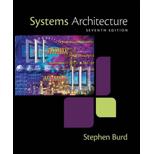
Hard disk:
Hard disk drive is a high-speed storage device that contains high capacity, which is built inside the system unit. It comprises of one or more flexible, circular platters use magnetic particles to store data or information.
- The rotating disks on disk drive are referred to as platters in which the programs and data are processed and stored with the results.
- Hard disks are separated into sections called as partitions.
- The partitioning of hard disk is required because if the user of the system requires to run more than one
operating system
Solid-state drives (SSD):
SSD stands for Solid State Drive. It is a non-volatile secondary storage that stores the data on solid state flash memory and it contains individual processor to manage and control its storage.
Explanation of Solution
Sites that provide useful information:
The sites that provide useful information for searching about the storage devices are “www.tomshardware.com” and “www.itworld.com”.
Sites that enables to find the information easier:
The site that enables to find the information easier is www.tomshardware.com. This site provides detailed description and specification of the device and thus it makes the user to find the required products.
Sites having large number advertisement:
The site that displays large number of advertisement is “www.networkworld.com”. While surfing on this page, it pops with different advertisement and makes the user to navigate to different links...
Trending nowThis is a popular solution!

- There are several types of digital memory available, including hard disk drives (HDD), random access memory (RAM), solid state drives (SSD), and cache memory. What is the advantage of having many memory standards, and what would be the advantage to consumers if there was just one, such as the various sizes of SSDs? Is it feasible that adopting a single standard would save money and provide more convenience for customers?arrow_forwardIdentify and briefly describe the benefits and drawbacks of both magnetic secondary storage devices and solid state secondary storage systems.arrow_forwardImagine that you have been tasked with creating new storage devices like the floppy disk drive or the flash drive. How do you proceed with this plan? Spell it out for us in fine detail.arrow_forward
- Discuss the evolution of storage technologies, from magnetic tapes to modern NVMe SSDs. Highlight the major milestones and breakthroughs in storage device development.arrow_forwardDiscuss the impact of "zoned storage" in enhancing the capacity and performance of modern storage devices.arrow_forwardPLEASE I NEED URGENTLY AND EXPLAIN DEEPLY NO COPYPASTE NO HANDWRITING THANK YOU :) TASK Explain the communication between the following system components and their connecting ports or devices. (RAM, ROM, CPU, Northbridge, Southbridge, HDD, and graphics card. CRITERIA Explain the functionalities of system unit components and how they communicate (RAM, ROM, CPU, Northbridge, Southbridge, HDD and Graphics Card).arrow_forward
- Let's say you're in charge of developing new storage media like the floppy disk drive or the flash drive. What steps must you take to bring this strategy to fruition? Define precisely what you mean.arrow_forwardLet's say you've been given the duty of developing new forms of data storage, such floppy disc drives or flash drives. How do you make this strategy a reality? Define your terms.arrow_forwardDiscuss the benefits and drawbacks of cloud storage. Can you name a few companies that offer cloud-based solutions?arrow_forward
- Assume you've been tasked with the job of creating storage devices such as a floppy disc drive or a flash drive. What steps do you need to take to fulfil this plan? Provide specifics.arrow_forwardImagine you oversee the manufacturing of several types of data storage media, such as USB flash drives and floppy disks. In what sequence do you need to do these things to make this plan work? In other words, be specific.arrow_forwardYou may choose from a variety of digital memory types such as hard disk drives (HDD), random access memory (RAM), solid-state drives (SSD), and cache memory. Would it be more advantageous for customers to have just one memory standard, such as the several sizes of SSDs? Would a single standard save customers money and make their lives easier?arrow_forward
 Systems ArchitectureComputer ScienceISBN:9781305080195Author:Stephen D. BurdPublisher:Cengage Learning
Systems ArchitectureComputer ScienceISBN:9781305080195Author:Stephen D. BurdPublisher:Cengage Learning
